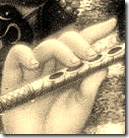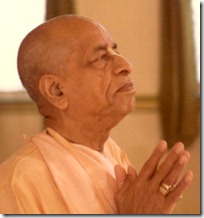 “Seeing
Rama in such a condition, the king of monkeys, Sugriva, who is grateful
and true to his promise, will give up his life. Being depressed,
aggrieved, sad, and full of miseries, poor Ruma will give up her life,
being tortured by the grief for her husband.” (Hanuman, Valmiki
Ramayana, Sundara Kand, 13.28-29)
“Seeing
Rama in such a condition, the king of monkeys, Sugriva, who is grateful
and true to his promise, will give up his life. Being depressed,
aggrieved, sad, and full of miseries, poor Ruma will give up her life,
being tortured by the grief for her husband.” (Hanuman, Valmiki
Ramayana, Sundara Kand, 13.28-29)
kṛtajñaḥ satya samdhaḥ ca sugrīvaḥ plavaga adhipaḥ ||
rāmam tathā gatam dṛṣṭvā tataḥ tyakṣyanti jīvitam |
durmanā vyathitā dīnā nirānandā tapasvinī ||
pīḍitā bhartṛ śokena rumā tyakṣyati jīvitam |
Shri
Hanuman, the faithful Vanara warrior, the eternally celebrated divine
figure of the Vedic tradition, has concern for every living being. Not
sidetracked by his own interests, he uses his love for the Supreme
Personality of Godhead to guide all of his decisions, his choices in
life. In others this natural impetus for action can get sullied through a
desire for self-aggrandizement or personal profit.
Hanuman
would become famous for his successes in one of the most difficult
missions in history, yet his concern was always directed at the innocent
people of his village back home, especially because of their close ties
to Shri Rama and His younger brother
Lakshmana.

Depending
on your angle of vision, bhakti-yoga can be considered a method of
mysticism aimed at removing distresses in life or it can be viewed as
the foremost occupational duty for the spirit soul. Bhakti is
multi-faceted, so we can’t just point to one activity and say that it is
the definitive embodiment of bhakti. Meditational yoga has its sitting
postures and breathing exercises,
jnana-yoga has its study of Vedanta philosophy, and
karma-yoga
has its fruitive work where the results are renounced for a higher
cause. Yet bhakti, which is nothing more than pure love for God, can
follow any activity. Even assuming a false guise, infiltrating an enemy
territory, and looking through different rooms inside of a palace for a
woman can be part of bhakti.
Just as the soldier is not punished
for his act of killing an enemy fighter, one who takes to seemingly
sinful behavior but for the proper cause does not suffer the negative
consequences. Just as if we let go of an object from our hand it will
fall to the ground, any action taken against the injunctions of
scripture will lead to a negative reaction in the future. Because of
this property the prohibited actions are considered sinful. If not for
the negative consequence, there would be no question of sin.
Lest
we think the guaranteed delivery of the unwanted side effects is just a
sectarian belief, we can see evidence of the negative reactions from
our own lives. If we were to run a red light, not only is there a chance
of getting a ticket, but there is every possibility of colliding with
traffic crossing from the sides, for they have a green light. If we eat
too much food, we will feel physical discomfort. If we don’t pay our
taxes, the government will eventually come after us. Each of these
actions goes against standard codes of conduct.
The scriptures,
the law codes instituted by the Supreme Lord at the beginning of
creation, are meant to guide human behavior. The animals are excluded
because they don’t have the intelligence to understand right and wrong
and the purpose to their existence. Children are also excluded, as the
responsibility for their actions falls squarely with the guardians. But
the adult human being, who has the capability to make a sober choice in
his pursuits, is advised to follow scriptural injunctions to avoid
punishment. Following the recommended rules and regulations allows for
advancement in consciousness, and going against the same obviously leads
the worker in the opposite direction. Like trying to reach the sky by
catching hold of falling raindrops, one who lives a life of sin and is
wholly averse to bhakti has no chance of advancing the plight of the
soul.
“For the soul there is never birth nor
death. Nor, having once been, does he ever cease to be. He is unborn,
eternal, ever-existing, undying and primeval. He is not slain when the
body is slain.” (Lord Krishna, Bhagavad-gita, 2.20)

How
can the soul advance? Does not the soul reside within a particular
body? Therefore if we want to move the soul somewhere, shouldn’t we just
take our body to that place? Though the soul dwells in a particular
form, it is known that it doesn’t stay there forever. The soul existed
prior to our birth, for Lord Krishna reveals in the Bhagavad-gita that
the soul does not ever have birth or death. Hence we know that the soul
will continue on long after the current life is finished. Something must
determine where the soul ends up, and according to revealed
information, that something is the sum collection of work and desires.
Just as if someone works hard to become physically fit and desires to
eat healthy they will get a lean and properly functioning body, someone
who desires the best end for the soul and takes to the necessary work
will be granted that reward in the future.
Yet bhakti is so nice
that one who practices it doesn’t have to wait until the distant future
to see results. They can place the soul in a happy place right away,
just by accepting the need to serve God. He is a singular entity, the
Supreme Lord, but based on time and circumstance He can be viewed
differently. Bhakti is considered the highest practice because only in
this discipline is the Supreme Personality taken for who He is, the best
friend of the living entities. God is most certainly the original
proprietor of everything and the ultimate enjoyer, but His inherent
friendship to everyone makes the spirit soul a candidate to act in the
Lord’s interests at all times, to enjoy His company. As God is not
limited to a single residence or personal form, He can accompany the
lonely soul in its travels just by appearing in a sound vibration. The
devotees practicing bhakti thus always chant sacred mantras like, “
Hare Krishna Hare Krishna, Krishna Krishna, Hare Hare, Hare Rama Hare Rama, Rama Rama, Hare Hare”, to keep their beloved’s company close by.
Hanuman, though using deceit and risking sinful behavior, was completely immersed in bhakti. Since Hanuman had
Lord Rama’s
image within his mind and was acting to please his beloved Rama, his
actions in Lanka were not sinful at all. Moreover, he turned a playing
field considered the “sin city” of its time into his sacrificial arena.
Just as a church is a building turned place of worship, any area can be
used to formally adore the Supreme Lord if it is sanctified properly. In
the Vedic tradition, the sacrificial arena is where the relevant
parties sit down together, chant sacred hymns, and offer oblations into a
fire to please the Lord of sacrifice, Yajneshvara. The Vedas tag God
with thousands of names to describe His limitless features and to give
the devoted souls more ways to address Him.
The land of Lanka,
an island hosting thousands of ghoulish creatures given to the worst
kind of sinful behavior, was Hanuman’s sacrificial arena, where he would
pour oblations into the fire to please Shri Rama.
Sita Devi,
Rama’s wife, had been taken to Lanka against her will by Ravana, the
king of the island. Hanuman’s duty was to find where Sita was and return
that information to Rama, who was stationed back at the camp in
Kishkindha. Hanuman was part of a monkey race known as Vanaras who lived
in the forests. Rama and His younger brother Lakshmana were there
looking for Sita, and through Hanuman’s efforts they formed an alliance
with the king of Vanaras, Sugriva.

Though
on a reconnaissance mission, Hanuman remained in the bhakti spirit.
Because of this he didn’t have to worry about sin. Though different
actions carry small and large consequences relating to future fortunes,
if one has the image of the Supreme Lord firmly etched within their
mind, how can any temporary consequence be considered beneficial or
negative? Hanuman already had Rama, so he didn’t need to worry about
where his soul would end up next or what type of situation he would
enjoy or suffer in the future.
Normally, if we were to reach
such a state of mind, the obvious effect would be to become callous to
the welfare of our friends, family, and community. I have God in my
mind, after all, so what do I care whether someone else is happy or not?
With the other kinds of yoga the aim is to find some level of
detachment. If we work hard and renounce the fruits of our labor, we
aren’t bound by the concern for loss or gain. If we study Vedanta and
learn that we are spirit soul not attached to the body, we will not have
concern over happiness or failure. By steady meditation in specific
asanas, the effects of the senses will be mitigated, thus allowing for the mind to ease its attachment to friends and family.
As
bhakti is the culmination of every kind of yoga practice, it would make
sense if Hanuman didn’t care about anyone except Rama. But God is the
source of everything, as the Vedanta-sutras so nicely state,
janmady asya yatah.
From one comes everything; from God has sprung forth the entire
creation. One who knows this understands that every creature has an
inherent link to the Supreme Lord, even if they are unaware of it. By
serving God in a mood of pure love, the compassionate attitude derived
from devotion will automatically extend to others. The topmost
transcendentalist is referred to as a
paramahamsa, or supreme
swan. He can extract the good from any situation. Even if he sees a
world full of sinners, since he knows they are linked to the Supreme
Lord, he thinks of how best he can bring about their salvation.
Conversely,
if the devotee should feel they are letting down the Supreme Lord, they
automatically think of how that failure will affect others. This is
what Hanuman faced in the situation in the above referenced verse. After
having braved every obstacle and searched far and wide, Hanuman had yet
to find Sita. Not surprisingly, he started pondering over what might
happen if he did actually fail in his mission. He had convinced himself
that Rama would renounce his life, Lakshmana right after, and then all
of Rama’s family in Ayodhya following them. Hanuman knew that Sugriva
was also hoping for Sita to be found, so if Hanuman returned to
Kishkindha and announced failure, the monkey king would surely give up
his body. The king’s wife Ruma would then have nothing to live for, so
she would also give up her body.

In
this way Hanuman essentially made himself responsible for the deaths of
everyone he loved and adored. Yet he had done nothing wrong up to this
point. He hadn’t taken Sita away, nor had he hidden her in a distant
island. Hanuman tried everything in his power to find Sita, so why
should he feel bad? Love is impossible to explain, especially when
talking about those who practice bhakti at the highest levels. Hanuman
would not settle for anything less than Rama’s complete satisfaction.
The pressure was already great on Hanuman, as he had no friends or
family with him while in a hostile territory. Rather, everyone in the
immediate vicinity was rooting for his failure, even though they didn’t
know he was there. Now that he made himself believe that everyone back
home would die from disappointment should he fail, Hanuman put even more
emphasis on his bhakti practices.
“O son of
Kunti [Arjuna], I am the taste of water, the light of the sun and the
moon, the syllable om in the Vedic mantras; I am the sound in ether and
ability in man.” (Lord Krishna, Bg. 7.8)
With this
kind of devotion, how could Hanuman ever fail? Shri Rama is the ability
in man, as He so nicely points out as Krishna in the Gita while
discussing matters of life and death and the properties of spirit with
His disciple and cousin Arjuna. Hanuman’s bhakti would lead to happiness
not only for Rama, but also for all of the Lord’s friends and family.
Hanuman was keenly aware of this, and he took the responsibility
assigned to him very seriously. Therefore it should be known without a
doubt that bhakti only increases our love for our fellow man, something
no other kind of yoga can claim to do. As everyone’s constitutional
position is to be engaged in God’s service, the bhakta isn’t shy about
sharing their wisdom about the meaning of life with others. This is the
kindest welfare work, as no temporary reward or sweet speech can provide
lasting benefits to the soul looking to match their loving propensity
with the proper beneficiary.
Just as Hanuman could survive in
enemy territory by remembering Rama, so we can manage our way through
the rough waters of the current age of quarrel and hypocrisy by
remembering Hanuman and his dedication. Time after time, in situation
after situation, Hanuman stepped up to the plate and delivered a top
notch performance. When he faced doubt and worried over what might
happen to his loved ones, he still didn’t give up. He kept fighting and
eventually succeeded. Not giving up remembering Hanuman will similarly
bring success in bhakti.
In Closing:
When on Supreme Lord only you depend,
Compassion for all humanity does extend.
For Hanuman, sea of doubt his mind did engulf,
But still only cared about others, not himself.
Shri Rama’s sadness Sugriva also would affect,
Then his wife Ruma too, body to reject.
This chain reaction Shri Hanuman saw,
Making himself ruination’s sole cause.
No matter, fight on with mission instead,
In finding Sita full speed ahead.
 When parents of middle school students participate in school-based, family interventions, it can reduce problem behavior, according to new research released online in the Journal of Adolescent Health. The transition to adolescence can be particularly challenging, as during this period, children are more likely to engage in potentially harmful behavior with their peers while having less monitoring from and communication with their parents. The researchers were interested in whether an intervention called the Family Check-Up (FCU)—a short program that provides feedback and skill training for parents—could mitigate some of the troubles many parents and teens face. “We hypothesized that we would find significant intervention effects on all four outcomes—family conflict, parental monitoring, antisocial behavior and alcohol use,” said Mark J. Van Ryzin, Ph.D., of the University of Oregon and lead author of the study. “We were pleased that these hypotheses were confirmed.”
When parents of middle school students participate in school-based, family interventions, it can reduce problem behavior, according to new research released online in the Journal of Adolescent Health. The transition to adolescence can be particularly challenging, as during this period, children are more likely to engage in potentially harmful behavior with their peers while having less monitoring from and communication with their parents. The researchers were interested in whether an intervention called the Family Check-Up (FCU)—a short program that provides feedback and skill training for parents—could mitigate some of the troubles many parents and teens face. “We hypothesized that we would find significant intervention effects on all four outcomes—family conflict, parental monitoring, antisocial behavior and alcohol use,” said Mark J. Van Ryzin, Ph.D., of the University of Oregon and lead author of the study. “We were pleased that these hypotheses were confirmed.” “Advancement
of material vision or material civilization is a great stumbling block
for spiritual advancement. Such material advancement entangles the
living being in the bondage of a material body followed by all sorts of
material miseries. Such material advancement is called anartha, or things not wanted.” (Shrila Prabhupada, Shrimad Bhagavatam, 1.8.27 Purport)
“Advancement
of material vision or material civilization is a great stumbling block
for spiritual advancement. Such material advancement entangles the
living being in the bondage of a material body followed by all sorts of
material miseries. Such material advancement is called anartha, or things not wanted.” (Shrila Prabhupada, Shrimad Bhagavatam, 1.8.27 Purport) How
can there be any contest in this matter? Nowadays we have microwaves,
internet, cellular telephones, high definition television sets,
automobiles and airplanes. Just from these basic advancements so much of
everyday life has changed. No longer do you have to worry about the
harsh winter coming to wreak havoc on your family. The drought in the
summer is also okay, for you can buy your food from some other source.
The vital provisions can be shipped in from an area where the harvest is
bountiful. Because of these options there is not so much of a reliance
on aspects of the past lifestyle which now seem primitive.
How
can there be any contest in this matter? Nowadays we have microwaves,
internet, cellular telephones, high definition television sets,
automobiles and airplanes. Just from these basic advancements so much of
everyday life has changed. No longer do you have to worry about the
harsh winter coming to wreak havoc on your family. The drought in the
summer is also okay, for you can buy your food from some other source.
The vital provisions can be shipped in from an area where the harvest is
bountiful. Because of these options there is not so much of a reliance
on aspects of the past lifestyle which now seem primitive. The
questions can be turned around though. Who is actually more advanced,
the person who is content with a simple lifestyle dedicated to service
to one particular entity or the person who requires constant expensive
change to feel stimulated in the mind? Let’s think of it another way.
Say we have two cellular telephone devices. They are identical except
for the performance of the battery. One phone has a battery that can
allow the phone to operate for up to a week with average use. The other
phone’s battery goes dead in a few days. Obviously the phone with the
stronger battery is superior, as it is more efficient. It can do more
work with the same amount of energy as can the other phone with the
inferior battery.
The
questions can be turned around though. Who is actually more advanced,
the person who is content with a simple lifestyle dedicated to service
to one particular entity or the person who requires constant expensive
change to feel stimulated in the mind? Let’s think of it another way.
Say we have two cellular telephone devices. They are identical except
for the performance of the battery. One phone has a battery that can
allow the phone to operate for up to a week with average use. The other
phone’s battery goes dead in a few days. Obviously the phone with the
stronger battery is superior, as it is more efficient. It can do more
work with the same amount of energy as can the other phone with the
inferior battery. How
do we connect with Krishna? Do we need the simple life of the farm or
the hustle and bustle of the city? While for the spiritualist it is easy
to put down the latest advancements in technology, can’t things like
e-readers and internet videos help one to connect with God? Aren’t these
outlets easier to use than the past requirements of having to travel to
a place where discussions on Krishna were being held? Shri Krishna,
being absolute, can be found through His holy names, which are put
together nicely in the perfect prayer known as the maha-mantra, “
How
do we connect with Krishna? Do we need the simple life of the farm or
the hustle and bustle of the city? While for the spiritualist it is easy
to put down the latest advancements in technology, can’t things like
e-readers and internet videos help one to connect with God? Aren’t these
outlets easier to use than the past requirements of having to travel to
a place where discussions on Krishna were being held? Shri Krishna,
being absolute, can be found through His holy names, which are put
together nicely in the perfect prayer known as the maha-mantra, “ On the other side, His Divine Grace
On the other side, His Divine Grace  The
supremacy of bhakti is proved by the efficiency of the workers who
follow it. Moreover, their superior standing validates the position of
Shri Krishna as the Supreme Personality of Godhead. Material life in an
advanced society requires exploitation of resources that aren’t so
abundant. With scarcity comes fierce competition, and with competition
comes a loss of compassion, leading to the predicament where everyone is
always suspicious of one another. Therefore it shouldn’t surprise us
that there are so many wars and constant strife in a life focused on
material pursuits.
The
supremacy of bhakti is proved by the efficiency of the workers who
follow it. Moreover, their superior standing validates the position of
Shri Krishna as the Supreme Personality of Godhead. Material life in an
advanced society requires exploitation of resources that aren’t so
abundant. With scarcity comes fierce competition, and with competition
comes a loss of compassion, leading to the predicament where everyone is
always suspicious of one another. Therefore it shouldn’t surprise us
that there are so many wars and constant strife in a life focused on
material pursuits. “Seeing
Rama in such a condition, the king of monkeys, Sugriva, who is grateful
and true to his promise, will give up his life. Being depressed,
aggrieved, sad, and full of miseries, poor Ruma will give up her life,
being tortured by the grief for her husband.” (Hanuman, Valmiki
Ramayana, Sundara Kand, 13.28-29)
“Seeing
Rama in such a condition, the king of monkeys, Sugriva, who is grateful
and true to his promise, will give up his life. Being depressed,
aggrieved, sad, and full of miseries, poor Ruma will give up her life,
being tortured by the grief for her husband.” (Hanuman, Valmiki
Ramayana, Sundara Kand, 13.28-29) Depending
on your angle of vision, bhakti-yoga can be considered a method of
mysticism aimed at removing distresses in life or it can be viewed as
the foremost occupational duty for the spirit soul. Bhakti is
multi-faceted, so we can’t just point to one activity and say that it is
the definitive embodiment of bhakti. Meditational yoga has its sitting
postures and breathing exercises, jnana-yoga has its study of Vedanta philosophy, and karma-yoga
has its fruitive work where the results are renounced for a higher
cause. Yet bhakti, which is nothing more than pure love for God, can
follow any activity. Even assuming a false guise, infiltrating an enemy
territory, and looking through different rooms inside of a palace for a
woman can be part of bhakti.
Depending
on your angle of vision, bhakti-yoga can be considered a method of
mysticism aimed at removing distresses in life or it can be viewed as
the foremost occupational duty for the spirit soul. Bhakti is
multi-faceted, so we can’t just point to one activity and say that it is
the definitive embodiment of bhakti. Meditational yoga has its sitting
postures and breathing exercises, jnana-yoga has its study of Vedanta philosophy, and karma-yoga
has its fruitive work where the results are renounced for a higher
cause. Yet bhakti, which is nothing more than pure love for God, can
follow any activity. Even assuming a false guise, infiltrating an enemy
territory, and looking through different rooms inside of a palace for a
woman can be part of bhakti. How
can the soul advance? Does not the soul reside within a particular
body? Therefore if we want to move the soul somewhere, shouldn’t we just
take our body to that place? Though the soul dwells in a particular
form, it is known that it doesn’t stay there forever. The soul existed
prior to our birth, for Lord Krishna reveals in the Bhagavad-gita that
the soul does not ever have birth or death. Hence we know that the soul
will continue on long after the current life is finished. Something must
determine where the soul ends up, and according to revealed
information, that something is the sum collection of work and desires.
Just as if someone works hard to become physically fit and desires to
eat healthy they will get a lean and properly functioning body, someone
who desires the best end for the soul and takes to the necessary work
will be granted that reward in the future.
How
can the soul advance? Does not the soul reside within a particular
body? Therefore if we want to move the soul somewhere, shouldn’t we just
take our body to that place? Though the soul dwells in a particular
form, it is known that it doesn’t stay there forever. The soul existed
prior to our birth, for Lord Krishna reveals in the Bhagavad-gita that
the soul does not ever have birth or death. Hence we know that the soul
will continue on long after the current life is finished. Something must
determine where the soul ends up, and according to revealed
information, that something is the sum collection of work and desires.
Just as if someone works hard to become physically fit and desires to
eat healthy they will get a lean and properly functioning body, someone
who desires the best end for the soul and takes to the necessary work
will be granted that reward in the future. Though
on a reconnaissance mission, Hanuman remained in the bhakti spirit.
Because of this he didn’t have to worry about sin. Though different
actions carry small and large consequences relating to future fortunes,
if one has the image of the Supreme Lord firmly etched within their
mind, how can any temporary consequence be considered beneficial or
negative? Hanuman already had Rama, so he didn’t need to worry about
where his soul would end up next or what type of situation he would
enjoy or suffer in the future.
Though
on a reconnaissance mission, Hanuman remained in the bhakti spirit.
Because of this he didn’t have to worry about sin. Though different
actions carry small and large consequences relating to future fortunes,
if one has the image of the Supreme Lord firmly etched within their
mind, how can any temporary consequence be considered beneficial or
negative? Hanuman already had Rama, so he didn’t need to worry about
where his soul would end up next or what type of situation he would
enjoy or suffer in the future. In
this way Hanuman essentially made himself responsible for the deaths of
everyone he loved and adored. Yet he had done nothing wrong up to this
point. He hadn’t taken Sita away, nor had he hidden her in a distant
island. Hanuman tried everything in his power to find Sita, so why
should he feel bad? Love is impossible to explain, especially when
talking about those who practice bhakti at the highest levels. Hanuman
would not settle for anything less than Rama’s complete satisfaction.
The pressure was already great on Hanuman, as he had no friends or
family with him while in a hostile territory. Rather, everyone in the
immediate vicinity was rooting for his failure, even though they didn’t
know he was there. Now that he made himself believe that everyone back
home would die from disappointment should he fail, Hanuman put even more
emphasis on his bhakti practices.
In
this way Hanuman essentially made himself responsible for the deaths of
everyone he loved and adored. Yet he had done nothing wrong up to this
point. He hadn’t taken Sita away, nor had he hidden her in a distant
island. Hanuman tried everything in his power to find Sita, so why
should he feel bad? Love is impossible to explain, especially when
talking about those who practice bhakti at the highest levels. Hanuman
would not settle for anything less than Rama’s complete satisfaction.
The pressure was already great on Hanuman, as he had no friends or
family with him while in a hostile territory. Rather, everyone in the
immediate vicinity was rooting for his failure, even though they didn’t
know he was there. Now that he made himself believe that everyone back
home would die from disappointment should he fail, Hanuman put even more
emphasis on his bhakti practices.